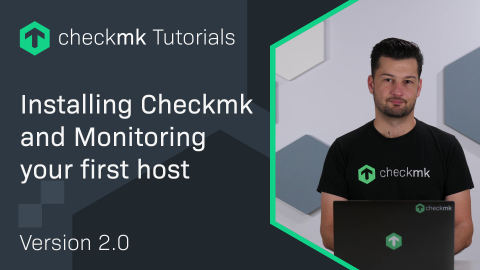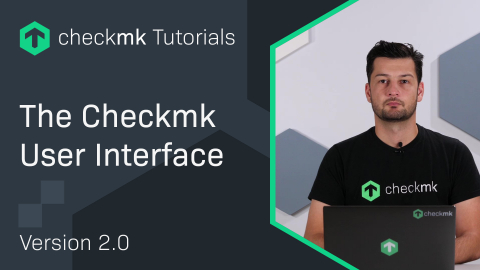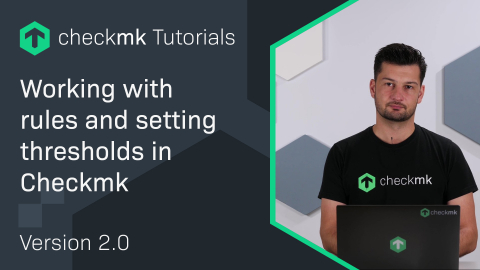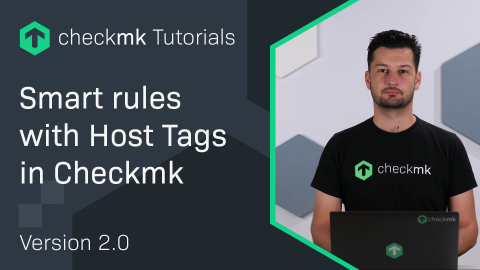Ep. 2: The Checkmk user interface and sidebar
Note: All the videos on our website offered in the German language have English subtitles and transcripts, as given below.
| [0:00:10] | Hello, and welcome back to the Checkmk Channel! |
| [0:00:13] | The last time – in Episode 1 – we installed Checkmk. |
| [0:00:17] | Today, in the second episode, I would like to show you the Checkmk user interface, and the simplest way for you to use it. |
| [0:00:23] | And so that it doesn’t get too boring, we will work with our own, tribe29, monitoring system. |
| [0:00:28] | Here you can see the start screen of our own monitoring system. |
| [0:00:31] | On the left side of the screen you can see the sidebar. |
| [0:00:33] | This contains various elements for displaying statuses and for navigation. |
| [0:00:37] | Before we look at the individual elements, I would first like to show you how to use this sidebar. |
| [0:00:43] | The most important thing is scrolling, because few of you will be able to fit all of the elements on a screen. |
| [0:00:48] | You have two options for scrolling: |
| [0:00:50] | If you have a mouse wheel, you can simply use it to slide the bar up and down. |
| [0:00:55] | The same goes for a touchpad of course, by swiping up and down with two fingers in parallel. |
| [0:01:00] | It is important here that the mouse pointer is always over the side bar. |
| [0:01:04] | Alternatively, you can simply grab one of the elements with the mouse and then drag it up and down. |
| [0:01:11] | You can also open and close any element by simply clicking on an element’s title. |
| [0:01:17] | You can see that the mouse pointer changes to a hand and the element opens or closes again. |
| [0:01:24] | The same goes for this small icon here, but since the icon is more difficult to hit I always just take the title. |
| [0:01:30] | If you are wondering what this little cross here is, just click it. |
| [0:01:33] | This is for removing the element. |
| [0:01:37] | Now, of course a good question is – “How do I get the element back if I accidentally remove it?” |
| [0:01:42] | You'll find a symbol down here. |
| [0:01:44] | This allows you to add elements to the sidebar, not just the ones you removed, but there are also a few other very interesting elements. |
| [0:01:53] | For example this one for quick access to WATO. |
| [0:01:58] | If you already know the texts, you can save a lot of space compared to the normal WATO snap-in, and simply click on these symbols. |
| [0:02:07] | I can easily recover the Bookmark snap-in that we removed earlier. |
| [0:02:11] | Just click it once, and it's back in my sidebar. |
| [0:02:17] | You can also move an element. |
| [0:02:20] | You go to the title bar – not the title itself – but in this empty area. |
| [0:02:24] | You will see the mouse pointer changes to a cross. |
| [0:02:27] | Now you just click with the left mouse button, hold it down, and you can move the element to a new location. |
| [0:02:33] | Before I show you some cool elements that you can put in your sidebar, I will first show you something else that I particularly enjoy namely the new Dark Theme. |
| [0:02:42] | To use this, go to the personal settings, go to User interface theme, and in Set custom theme and choose Modern (Dark). |
| [0:02:54] | The Dark theme is simply a screen theme in which the colors are kept very dark and mainly the status information shines brightly. |
| [0:03:03] | For example, you see green, red and yellow - very clearly - and the rest is in muted colors, so that you can actually work with them very comfortably. |
| [0:03:12] | And now I’m going to show you three cool snap-ins for your sidebar: |
| [0:03:17] | Let’s go back to the symbol for adding snap-ins, and to start, pick the Host-Matrix. |
| [0:03:23] | The Host-Matrix is here, it now ends up in the sidebar at the bottom, that’s why I'll close a few other snap-ins here and then it is very simple since you will see a box for every host in the monitoring system. |
| [0:03:38] | If there is a problem on the host, the box gets the color of the worst problem – red in this case. |
| [0:03:44] | You can also click on the box and receive the details for the corresponding host and see that there must be a red problem somewhere, and then you can get a quick overview. |
| [0:03:55] | This is of course not so useful beyond a certain number of hosts, but as long as that number is less than 100-200 hosts, it actually still works very well. |
| [0:04:05] | Another interesting snap-in is the Micro core statistics snap-in. |
| [0:04:10] | This is particularly interesting if you are monitoring more than a few hosts. |
| [0:04:14] | The snap-in shows you how well your monitoring system is performing. |
| [0:04:17] | What you see first is the number of checks per second i.e., in this example we have 38 checks that are being executed every second, the host checks, that is how many pings are executed per second and here these two settings are interesting: the Check helper usage and the Checkmk helper usage. |
| [0:04:36] | These should always be at about 80%. |
| [0:04:39] | When they are higher it means that your monitoring system does not have enough support processes to work fast enough. |
| [0:04:46] | In such a case you can simply increase them in the global settings. |
| [0:04:49] | The last snap-in that we’ll look at is called Folders, but before I do that I’ll tidy up here so that we can see a bit better - except for the Tactical overview, which I’ll leave in for now. |
| [0:05:00] | Out with it, out with it, out with it. |
| [0:05:02] | Now I go back to the snap-ins. |
| [0:05:05] | Next I’m going to get the Views snap-in back - the one I closed at the very beginning. |
| [0:05:09] | You really need this. |
| [0:05:11] | And right next to it, the Folders snap-in, which in fact works together with the Views snap-in. |
| [0:05:17] | If you manage your hosts in folders - and that is actually what you should always do. |
| [0:05:22] | In this snap-in you can easily see your folder structure and all of the hosts it contains. |
| [0:05:28] | I can, for example, now go in here and say network Fritzboxes and get the main dashboard, but now only see these three hosts in this folder. |
| [0:05:39] | I can do this with all views if I now choose any other view - here, for example, View all services then I will only see the services from this folder that I selected earlier. |
| [0:05:56] | I can now again choose another folder, for example, I can say that I just want to see the switches in the Hetzner subfolder, and I then only see all of the services in this folder. |
| [0:06:10] | So that’s it for today. |
| [0:06:12] | I hope it was interesting and that it was fun as well! |
| [0:06:14] | In the third episode we will look at how to monitor Windows. |
| [0:06:18] | Until then, I wish you all the best, and hope to see you soon. |
Interested in learning more? Register for a dedicated Synthetic Monitoring training course.








